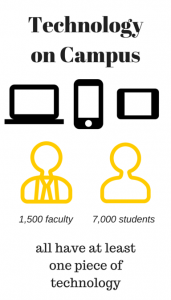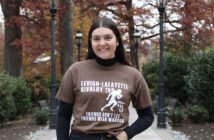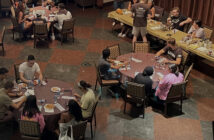The iPhone vibrates, emitting an audible buzz off the wooden table. The student glances in its direction, debating whether to check it now or later. He decides on the latter, bringing his focus back to his work as he studies in Fairchild-Martindale Library. His iPhone buzzes again, but this time there’s no contemplation as he reaches for it, forgetting for just a moment about the empty word document on his computer screen.
According to Lehigh University’s At A Glance website, Lehigh has roughly 7,000 graduate and undergraduate students. In addition to Lehigh’s students, there are more than 500 full-time professors and nearly 1,000 administrative staff members. Of the 7,000 students and 1,500 faculty and staff members, all own or have access to at least one piece of technology, whether that be a cell phone, laptop or tablet. With that extensive access to technology comes a dependency to it. The challenge then is finding the right balance of when to log in and when to unplug.
Greg Reihman, the director of the Center for Innovation in Teaching and Learning, knows how difficult it can be to find that balance. He works with faculty to brainstorm ways of implementing new forms of technology and teaching into a classroom setting. When he isn’t inspiring ideas or supporting faculty projects, he’s teaching philosophy classes. His work with both faculty and students has made him realize how significant technology is on campus and in life.
“I worry about the ability to be alone with our thoughts because everything is a distraction and so instant,” Reihman said. “The role of the university is not just to teach students how to be successful within this technology-rich environment, but also to see where technology might have its edges and how to step outside that.”
Bruce Taggart, the vice provost of Library and Technology Services, is on the forefront of working with the university to find ways to step beyond technology’s edges. He hopes to one day make learning at Lehigh a much more collaborative experience where students aren’t dependent on technology, but know how to use it effectively in their learning.
Taggart’s goal in the next five years is to completely renovate Fairchild-Martindale Library into a collaborative learning space filled with technologically advanced classrooms and whiteboards. Whiteboards, he says, are the epitome of high-tech and low-tech learning where students can express their ideas. Whiteboards might not seem like a typical advancement in technology, but when Taggart looks at a whiteboard, he sees much more than a blank slate. He sees possibilities.
“There’s a whole new generation of students coming through,” Taggart said. “Once we renovate the rest of the library, the whole ground floor will be a café, but it’s not just a café. It’s where you meet collaboratively, meet with faculty and where there will be whiteboards everywhere. Hopefully it’ll be the technology that will change how students learn.”
Changing the way students learn is also the top priority of the Mellon Grant Digital Humanities program that will be implemented in July 2015. The project aims to help undergraduate humanity students engage with the local community through digital tools, ranging from videography to website creation. Ed Whitley, an associate professor of English who is spearheading the project, says that instead of final papers in classes, students could be creating documentaries or submitting a collection of photographs.
“I’m most excited for the long-term potential,” Whitley said. “The grant is for three years, and it could attract attention to the kind of work that we could do at Lehigh and make it something that becomes very integral to the way we teach and research.”
Despite the advancements in programs developing learning and technology at Lehigh, academics aren’t the only application of technology in student and faculty everyday life. Social networking sites, apps and texting have become a major part of the way faculty and students communicate. Yet being connected can also have negative downsides, especially for the environment.
According to Eco-Reps coordinators, Victoria Yu, ’16, and Matthew Moschella, ’15, the constant use of technology causes an unnecessary energy drain that could easily be fixed by unplugging a device. Although they agree on how Lehigh can do a better job of conserving energy by powering down computers, tablets and phones when not in use, they disagree on whether being connected is a good thing.
“Our generation is way too attached to technology, and we are so unaware of our addiction,” Moschella said.
Unlike Moschella who goes so far to say technology is becoming an addiction, Yu sees technology as a necessity in college, but also agrees that sometimes it’s best to unplug.
“I don’t think it’s bad that students are attached to technology,” Yu said. “A lot of professors here require students to complete homework or assignments online. But I do think that students could use more time disconnected from technology and social media and to enjoy their time offline.”
Across all three colleges, professors require students to complete a majority of their assignments online, or even participate in class by using social media sites. Journalism professor Jeremy Littau uses a variety of social media sites like Twitter, Instagram, Tumblr, Reddit and many others in his classes.
Littau selects the types of technology he teaches based on how a student can learn and create with it. Most notably, Littau’s Multimedia Storytelling class gives students the opportunity to use Google Glass, resulting in creative first-person perspective documentaries and photos.
“I try to think about the technology I use in class in terms of how students are going to use it and learn from it,” Littau said. “How can we make things with it? How can we create with it?”
Other professors aren’t as lenient in their technology policies in the classroom. Judith Lasker, a sociology and anthropology professor, recognizes that things like social media can be a distraction to the learning process.
“I tell students they can’t have their own phones or laptops out because I am fully aware of how easy it is to get distracted by messages and social media, and that’s distracting to other students and to me,” Lasker said.
In addition to technology’s possible distractions, researchers outside of Lehigh are also concerned that social media tools are changing the way people think. In the 2013 study “Major memory for microblogs,” researchers conducted an experiment on undergraduate students at the University of California, San Diego. It was found that test subjects had an easier time remembering Facebook posts than they did human faces and sentences from books. The experiment findings hinted that short posts like text messages, Twitter or Facebook are altering the brain to think in shorter thoughts.
Although the way people think might be slowly changing, technology is not. Lehigh is fully aware of how quickly technology alters, and is working through grants, architectural renovations and faculty learning to stay ahead inside and outside of the classroom. Technology will remain a powerful influence in all areas of people’s lives. So as an iPhone vibrates or an empty word document is left blank while responding to a text, finding the balance between logging in and unplugging will remain a constant challenge.






Comment policy
Comments posted to The Brown and White website are reviewed by a moderator before being approved. Incendiary speech or harassing language, including comments targeted at individuals, may be deemed unacceptable and not published. Spam and other soliciting will also be declined.
The Brown and White also reserves the right to not publish entirely anonymous comments.